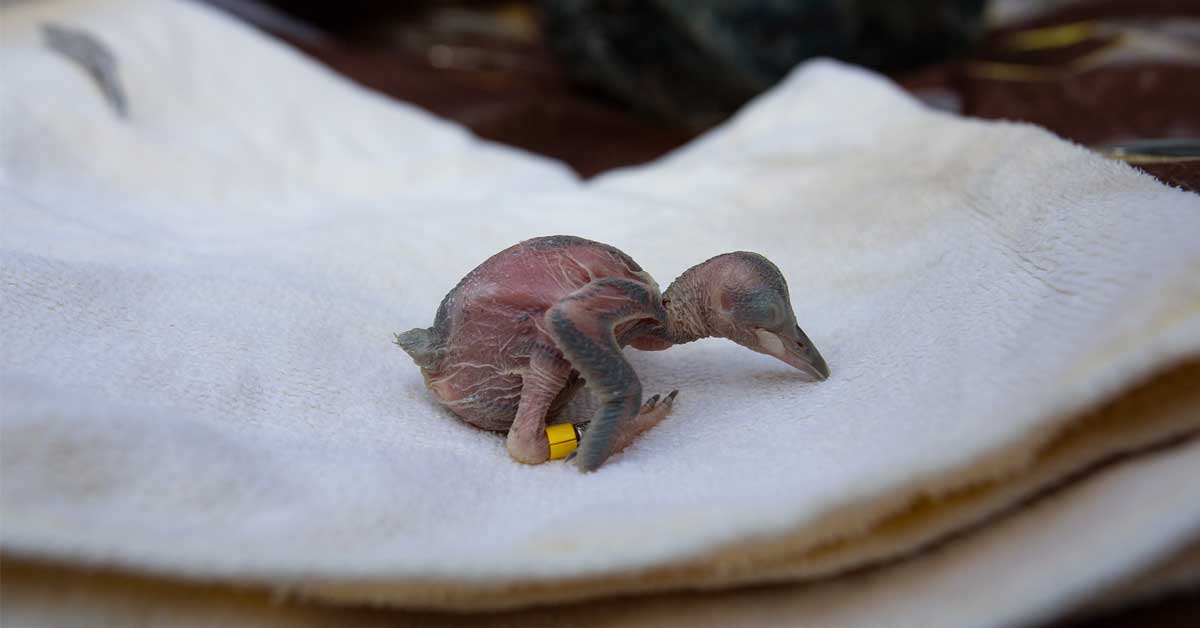
By Sergio Harding, Bird Conservation Biologist, Virginia Department of Wildlife Resources
Photos by Lynda Richardson, Virginia Wildlife Art Director, Virginia Department of Wildlife Resources
On the morning of May 16, a group of thirteen met at the Big Woods Wildlife Management Area (WMA) in Sussex County for what was to be a landmark conservation event: the banding of two nestlings of the federally endangered Red-cockaded Woodpecker, the first ever to be hatched on the WMA. Banding is used to keep track of individuals in this small yet growing population of the woodpecker, which has recently expanded onto Big Woods from the abutting Piney Grove Preserve.

Climbing the nest tree at Big Woods WMA.
Tired yawns could not stifle the air of excitement as the group gathered – there were representatives from DWR, The Nature Conservancy (TNC) and the Center for Conservation Biology at the College of William and Mary/Virginia Commonwealth University (CCB). All three entities have been partners in conservation efforts for the woodpecker in Virginia, and the banding was to be the culmination of all the time, energy and work that has gone into this project since DWR acquired Big Woods in 2011*.
The group hiked to the woodpeckers’ territory amid ebullient conversation. Using specialized sectional ladders, Bryan Watts of CCB climbed nearly 40 feet up a live pine tree to the nest cavity, and from it he carefully extracted the nestlings. It was at this moment that the group’s excited chatter abruptly gave way to reverential silence: all present understood the significance of this moment, and maintained their silent focus as the birds were brought down to the ground and the banding proceeded.
The two young birds, at 6 days old, weighed only ¾ oz each, were featherless and had not yet opened their eyes. They were naked and helpless, and their appearance was vaguely reptilian. Chance Hines from CCB banded each with a federal aluminum band and a combination of brightly colored plastic leg bands. At that point, wide grins and fist bumps erupted among the gathering. Within a few minutes, the chicks were safely returned to their nest, and the parents were soon back to feeding them.


A series of small milestones led us to this day. The male of the pair found its way to Big Woods in 2017 from nearby Piney Grove, which harbors a small population of the species. In 2018 he paired with a female, also from Piney Grove, but the two did not breed. Eggs were first confirmed in the nest cavity on April 24 of this year, and nestlings on May 10th. The young birds are expected to leave the nest in early June, fully feathered with handsome black and white plumage. Confirming their successful fledging from the nest will be another cause for celebration.

Red-cockaded Woodpecker female feeds her nestlings after they are returned to the nest cavity.
As exciting as the moment was, we are but at the beginning of a long journey. Preceding the birds’ arrival to the WMA was intensive habitat management, including controlled burns and strategic tree thinning, to create the open pine savanna conditions that the species requires. And we continue to move forward by improving even more habitat to assist the expansion of the woodpecker’s population onto the WMA from nearby Piney Grove Preserve. This habitat management benefits not only the Red-cockaded Woodpecker, but the entire bird community, including species like turkey and quail. As we continue with our habitat work, we welcome all of them with open arms.
How to Support Red-cockaded Woodpeckers in Virginia

- Purchase a Restore the Wild Membership to support the DWR’s habitat restoration work, such as that accomplished at Big Woods WMA. The membership also serves as your pass to visiting Big Woods WMA and over 40 other WMAs throughout the Commonwealth.
- Consider participating in a Safe Harbor Agreement, if you are a landowner with property adjacent to Piney Grove Preserve, Big Woods WMA, or Great Dismal Swamp National Wildlife Refuge.
- If visiting red-cockaded woodpecker viewing areas, such as at Big Woods WMA, please stay out of the marked stands of trees that hold the woodpeckers’ cavities. Do not approach, pursue the birds, or play callback recordings—all of which are considered harassment of this endangered species.
- To learn more about Red-cockaded Woodpeckers and their history in Virginia, visit their species profile on the DWR website.
*DWR acquired Big Woods WMA through funds obtained from the U.S. Fish and Wildlife Service’s Recovery Land Acquisition Grant, specifically in service of conservation for the federally endangered Red-cockaded Woodpecker.


